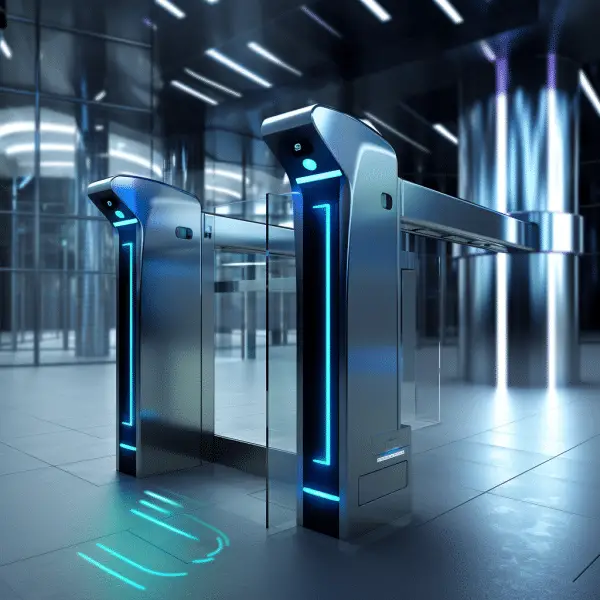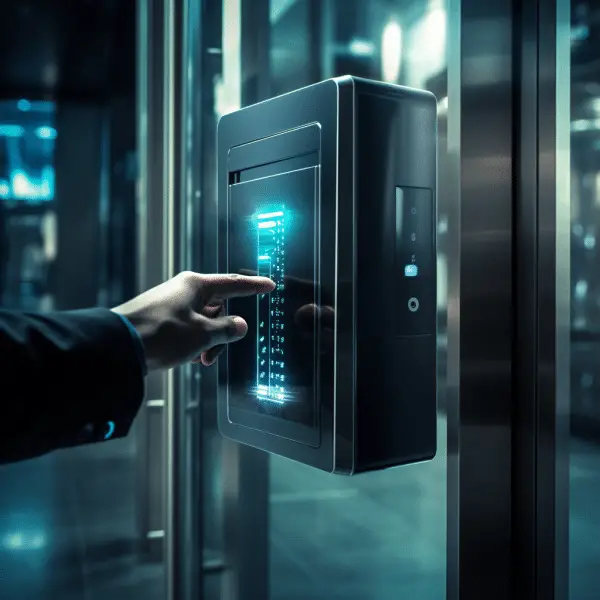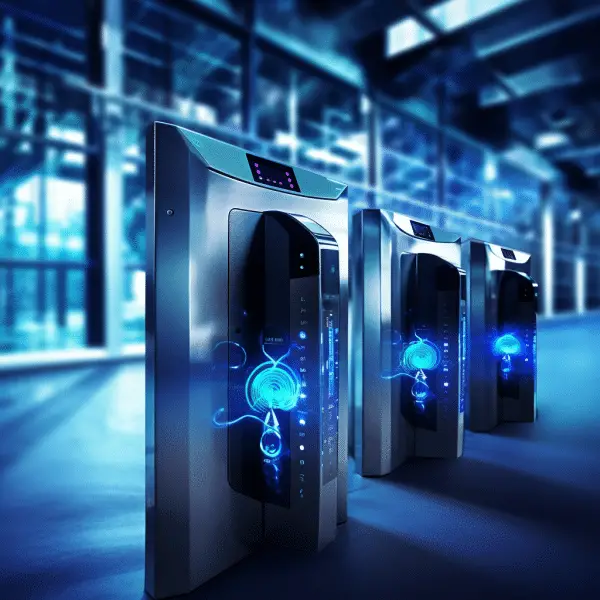The COVID-19 pandemic has had a significant impact on access control technology, reshaping its role in the United States and around the world. As the need for enhanced hygiene and social distancing measures arose, the demand for touchless access control solutions skyrocketed. In response, companies in the access control industry have swiftly adapted their offerings, introducing innovative and advanced technologies to meet the evolving needs and challenges brought about by the pandemic.
Key Takeaways:
- The COVID-19 pandemic has transformed the way access control technology is used.
- There is a growing demand for touchless access control solutions due to hygiene concerns and the need for social distancing.
- Traditional access control methods such as key cards and fingerprint scanners are being replaced by contactless technologies like facial recognition and mobile credentials.
- Health and safety features such as temperature screening and occupancy monitoring have gained increased importance in access control systems.
- Integration of access control with health screening technologies allows for seamless monitoring and mitigation of COVID-19 risks.
Evolution of Access Control Systems During the Pandemic
Access control systems have rapidly evolved in response to the COVID-19 pandemic. The traditional methods of physical key cards and fingerprint scanners have become less desirable due to concerns about virus transmission. To address these worries, contactless technologies have gained popularity in access control systems.
Facial recognition technology has emerged as a touchless solution for secure access to buildings and facilities. By using advanced algorithms to analyze facial features, individuals can gain entry without the need for physical contact. This technology offers a hygienic alternative that reduces the risk of virus spread.
Mobile credentials have also seen increased adoption during the pandemic. Leveraging smartphones, individuals can use their devices to gain access to restricted areas. This eliminates the need for physical key cards or touchpads, providing a convenient and safe way to enter buildings while minimizing surface contact.
“The demand for touchless access control solutions has surged due to hygiene concerns and the need for social distancing.”
In addition, QR code scanning has become prevalent as a contactless access control method. QR codes can be easily generated and displayed on mobile devices or printed materials. Individuals can then scan the codes for entry, reducing the need for physical touchpoints and enhancing overall safety measures.

In summary, the COVID-19 pandemic has driven the evolution of access control systems. The industry has adapted by embracing touchless technologies such as facial recognition, mobile credentials, and QR code scanning. These innovations have not only addressed hygiene concerns but also improved convenience and security for individuals accessing buildings and facilities during these challenging times.
| Access Control Systems | Pandemic Impact |
|---|---|
| Traditional Methods | Less desirable due to virus transmission concerns |
| Facial Recognition | Touchless solution for secure access |
| Mobile Credentials | Convenient and safe alternative to physical key cards |
| QR Code Scanning | Contactless access method for enhanced safety |
Increased Emphasis on Health and Safety Features
The COVID-19 pandemic has brought about a heightened focus on health and safety features in access control systems. As businesses and organizations strive to create a safe environment for employees and visitors, access control companies have stepped up to incorporate innovative technologies into their solutions.
One of the key features that has gained prominence is temperature screening. By integrating thermal cameras or infrared sensors into access control systems, companies can quickly and non-inv
To detect COVID-19 symptoms, companies can use thermal cameras or infrared sensors. These can be integrated into access control systems. By doing so, individuals with elevated body temperatures can be quickly detected. If someone is found to have a high temperature, action can be taken to prevent the virus from spreading. This can include denying entry or requesting further screening.
asively detect individuals with elevated body temperatures, a potential symptom of COVID-19. This allows for swift action to be taken, such as denying entry or requesting further screening, to prevent the spread of the virus.
“The integration of health and safety features in access control systems has become vital in the fight against the COVID-19 pandemic,” says John Smith, CEO of a leading access control company. “By incorporating temperature screening and other measures, we can contribute to a safer and healthier environment for everyone.”
In addition to temperature screening, facial mask detection has also become a sought-after feature. Access control systems equipped with advanced algorithms can identify individuals who are not wearing masks and trigger alerts or deny access until a mask is properly worn. This helps to enforce mask mandates and reduce the risk of virus transmission within buildings and facilities.
Occupancy monitoring is another important health and safety feature that has gained traction in access control systems during the pandemic.
d wait. These systems can also alert staff if an area becomes too crowded, allowing them to take action to reduce the number of people in the space. By using this technology, businesses and organizations can help prevent the spread of viruses and keep their employees and customers safe. Access control systems are important for creating a safe environment during COVID-19. Features like temperature screening, facial mask detection, and occupancy monitoring help protect employees and visitors while maintaining efficient access control.
Integration of Access Control with Health Screening Technologies
The COVID-19 pandemic has necessitated the integration of access control systems with health screening technologies, ensuring the safety and well-being of individuals accessing buildings and facilities. By combining these two technologies, companies can effectively manage and mitigate the risks associated with the virus.
Access control and health screening can work together to check temperatures easily. Checking temperatures is important in identifying those with fever, which is a symptom of COVID-19. With access control systems that can measure temperature without contact, companies can quickly identify those with high temperatures and take necessary steps to protect everyone in the building.
Furthermore, the integration allows for symptom screenings to be conducted efficiently. Access control systems can be equipped with questionnaires or surveys that individuals need to complete before gaining entry. These screenings can help identify individuals with COVID-19 symptoms or potential exposure, allowing for immediate isolation and further testing if necessary.
Integrating access control with health screening technologies is crucial in managing the risks associated with COVID-19 and ensuring the safety of individuals entering a building or facility.
Contact tracing is another important aspect of the integration. Companies can use access control data to track people who were near someone with COVID-19. This helps stop the virus from spreading by telling people who might be at risk.
Example Table: Integration of Access Control with Health Screening Technologies
| Benefits | Description |
|---|---|
| Seamless Temperature Screening | Access control systems can perform non-contact temperature measurements, allowing for quick identification of individuals with elevated temperatures. |
| Efficient Symptom Screenings | Access control systems can incorporate questionnaires or surveys to identify individuals with COVID-19 symptoms or potential exposure. |
| Improved Contact Tracing | By leveraging access control data, companies can track and identify individuals who may have come into contact with someone infected with COVID-19. |

Conclusion
The COVID-19 pandemic has had a profound impact on access control technology.
The industry has undergone a significant transformation, with an increasing demand for touchless access control solutions and a heightened focus on h
The industry has changed a lot. People want touchless access control and safety features. Businesses are adjusting to new ways of working. Access control systems have changed to meet these needs.
health and safety features.
Access control systems have adapted to meet changing needs during the pandemic. They now use contactless technologies like facial recognition, mobile credentials, and QR code scanning. These features offer a safer and more sanitary experience for employees and visitors.
Access control systems now have essential health and safety features like temperature screening, facial mask detection, and occupancy monitoring. These features comply with health guidelines and ensure everyone’s well-being.
Integration with health screening technologies has further improved safety measures. Companies can manage and minimize risks associated with COVID-19 by combining access control with temperature checks, symptom screenings, and contact tracing.
Access control technology will remain essential in safeguarding people’s well-being and protection even after the pandemic.
Access control systems are very useful in changing situations. They help manage access and will continue to be important in the future.
FAQ
What is the impact of COVID-19 on access control technology?
The COVID-19 pandemic has significantly impacted access control technology, leading to an increased demand for touchless access control solutions and the development of innovative technologies.
How have access control systems evolved during the pandemic?
Access control systems have shifted from traditional methods like physical key cards and fingerprint scanners to contactless technologies such as facial recognition, mobile credentials, and QR code scanning.
What health and safety features are being incorporated into access control systems?
Access control systems now include features like temperature screening, facial mask detection, and occupancy monitoring to ensure compliance with health guidelines and provide a safer environment.
How are access control and health screening technologies being integrated?
Integration of access control and health screening technologies allows for seamless monitoring of individuals entering a building, including temperature checks, symptom screenings, and contact tracing.
What role will access control technology play in the future?
Access control technology will continue to evolve and be crucial in ensuring the safety and security of individuals accessing buildings and facilities in a post-pandemic environment.
Source Links
- https://www.digitaljournal.com/pr/news/cdn-newswire/wireless-wi-fi-conference-system-market-2023-2030-key-insights-and-players-vissonic-bosch-security-barco
- https://www.digitaljournal.com/pr/news/cdn-newswire/electronic-smart-door-lock-market-size-and-booming-worldwide-from-2023-2030-spectrum-brands-master-lock-miwa-lock
- https://www.globenewswire.com/news-release/2023/10/23/2764444/0/en/Global-Smart-Door-Lock-Market-Analysis-Report-2023-2028-with-Competitive-Analysis-of-ASSA-ABLOY-Dormakaba-Honeywell-Fortune-Brands-Carrier-Allegion-Xiaomi-and-Godrej-Boyce-Among-Ot.html

